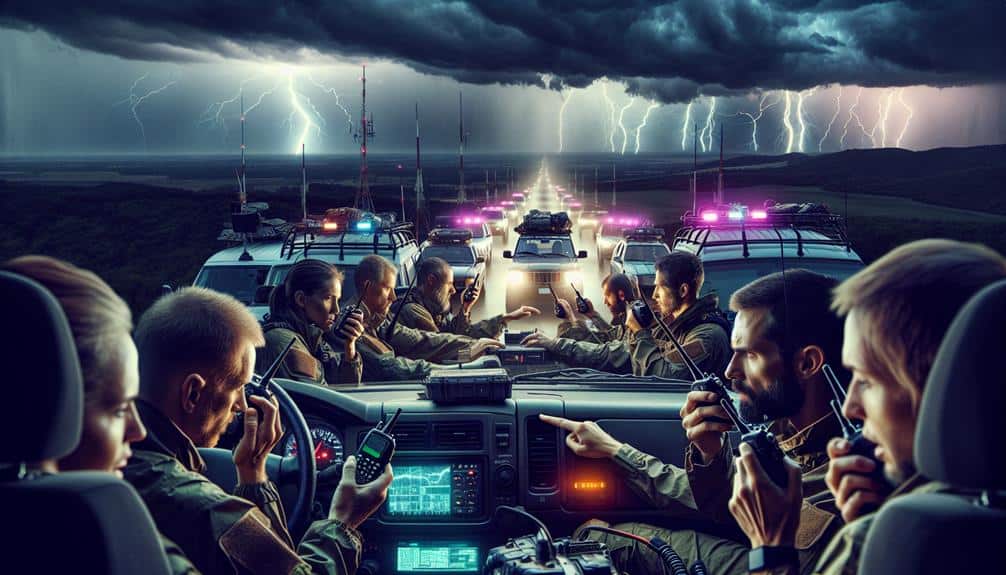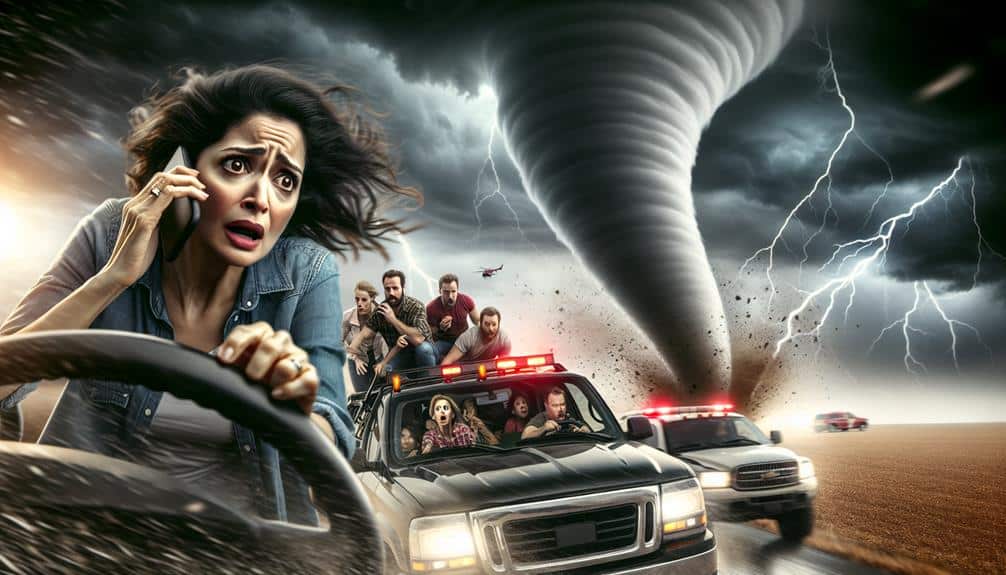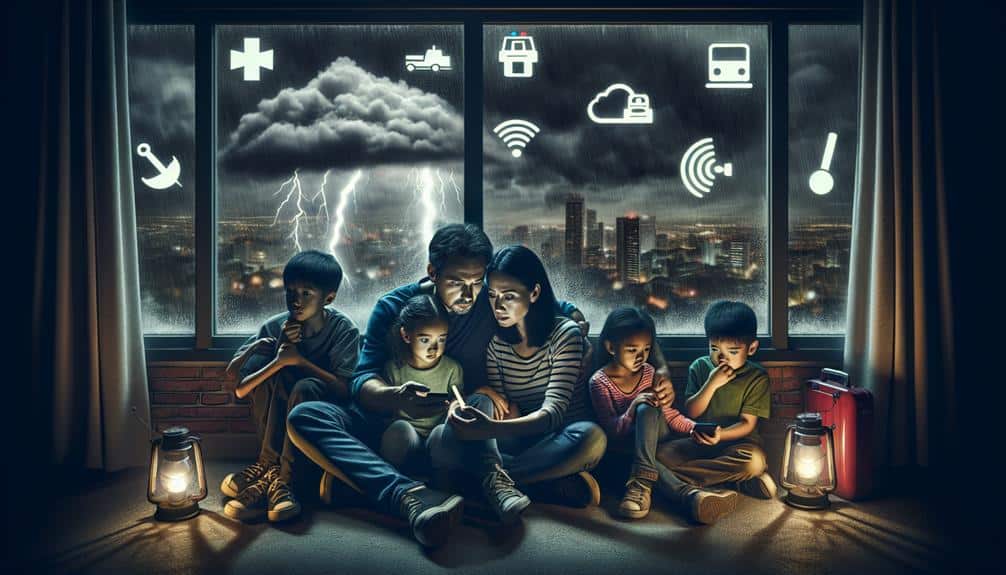Clear communication is essential in storm chasing to guarantee accurate data collection, direct coordination with authorities, and the management of road hazards. We've got to cross-reference findings, adhere to communication protocols, and utilize encrypted channels for sensitive information. Effective communication allows us to relay real-time updates to local authorities and emergency teams efficiently. It helps us safely navigate changing conditions using GPS and real-time traffic apps. Most importantly, it enables swift and correct decision-making, enhancing overall safety and response times. For more insights, let's explore how each component plays a critical role.
Key Points
- Enables swift decision-making and immediate action during rapidly changing storm conditions.
- Prevents team members from driving into hazardous areas with real-time alerts.
- Ensures accurate and timely sharing of meteorological data with authorities and team members.
- Enhances coordination with local authorities for effective storm tracking and hazard management.
Ensuring Accurate Information
To confirm accurate information, we must meticulously verify data sources and cross-reference findings with established meteorological standards. This validates our observations are reliable and actionable.
By adhering to stringent communication protocols, we maintain the integrity of our data, which is vital for storm chasers who depend on precise information to make split-second decisions.
We start by collecting data from multiple reputable sources, including satellite imagery, radar systems, and weather stations. Cross-referencing these data points helps us identify any discrepancies and guarantees data accuracy. This analytical approach minimizes errors and enhances the credibility of our findings.
Effective communication protocols also play a significant role. By standardizing how we report weather conditions, we guarantee that everyone in our team understands the information in the same way. This uniformity prevents misinterpretations that could lead to dangerous situations.
We use encrypted channels for sensitive data to safeguard against unauthorized access, ensuring the information remains both precise and secure.
Coordinating With Authorities
Maintaining precise data is only part of the equation; we must also coordinate closely with local authorities to verify our findings are effectively utilized for public safety. This coordination hinges on robust communication protocols. By establishing clear and consistent methods of sharing real-time weather updates, we guarantee that emergency alerts are disseminated efficiently. Local authorities rely on our timely information to make critical decisions, such as issuing evacuation orders or mobilizing emergency services.
Our collaboration efforts extend beyond mere information sharing. We engage in regular briefings with meteorologists, emergency management teams, and law enforcement to synchronize our activities. This collaboration allows us to adapt rapidly to changing weather conditions and provide the most relevant and up-to-date data. In doing so, we enhance the overall effectiveness of public safety measures.
Furthermore, maintaining open channels of communication with local authorities verifies that any discrepancies in data are promptly addressed. This ongoing dialogue helps us refine our methods and improve our predictive models, ultimately contributing to more precise weather updates. In this way, our coordinated efforts not only protect individual freedoms by keeping communities informed but also bolster the resilience of entire regions facing severe weather events.
Managing Road Hazards
Traveling through harsh weather conditions requires us to anticipate and manage road hazards effectively. Accurate weather updates are essential for identifying potential threats such as flooded roads, fallen trees, and debris. By staying informed, we can make strategic decisions about our routes, guaranteeing our safety and the success of our mission.
Effective communication with traffic control authorities is equally important. Real-time information from these sources helps us avoid congested or closed roads. This coordination allows us to navigate more freely, minimizing delays and avoiding unnecessary risks. We must always be prepared to adapt our plans based on the latest data, which underscores the significance of a reliable communication system.
Additionally, we employ advanced technology such as GPS and real-time traffic apps to monitor road conditions. These tools, combined with constant weather updates, enable us to swiftly alter our course as needed. The ability to respond dynamically to changing conditions is vital; it ensures we can continue our pursuit while maintaining the highest level of safety.
Ultimately, clear communication and the ability to manage road hazards effectively provide us with the freedom to chase storms without compromising our well-being or that of others on the road.
Swift Response Times
Our ability to manage road hazards directly impacts our need for quick response times in rapidly evolving storm conditions. When we face unpredictable weather, swift decisions are essential.
Effective communication becomes our lifeline, enabling us to relay vital information instantaneously. This communication guarantees that every member of our team is aware of the storm's path, potential hazards, and the most efficient routes for evacuation or repositioning.
Proper equipment also plays a central role in achieving quick response times. High-quality radios, GPS systems, and weather monitoring tools allow us to gather and share real-time data. These tools enable us to anticipate changes and communicate those changes promptly. Without proper equipment, our response times would be greatly hindered, putting both our mission and our safety at risk.
It's not just about speed; it's about precision and coordination. When we communicate effectively, we can synchronize our movements and actions, ensuring that we react not only quickly but also correctly.
This synchronization is vital for maintaining the agility needed to navigate storm conditions. Ultimately, our commitment to clear communication and the use of proper equipment guarantees that we can act quickly and decisively, embracing the freedom to pursue our passion safely.
Enhancing Team Safety

Securing team safety demands strict protocols and continuous vigilance in the face of unpredictable storm conditions. Effective team coordination is vital for us to navigate hazardous environments and mitigate risks. By maintaining clear communication, we guarantee that everyone is aware of their roles and responsibilities, which is essential for executing emergency protocols efficiently.
Clear communication allows us to share real-time updates on storm trajectories, road conditions, and potential hazards. This information enables us to make informed decisions quickly, enhancing our overall safety. Visualizing these scenarios helps us understand the importance:
- A sudden shift in the storm's path: Immediate alerts prevent team members from driving into danger zones.
- Vehicle malfunction in severe weather: Quick coordination ensures that help is dispatched promptly, minimizing exposure to hazardous conditions.
- Medical emergencies: Rapid communication allows for the swift execution of medical protocols, securing the well-being of affected individuals.
Frequently Asked Questions
How Do Storm Chasers Prepare Their Equipment Before Chasing a Storm?
We meticulously prepare our equipment by following strict safety protocols. We check all instruments for data collection accuracy, validate all batteries are charged, calibrate sensors, and confirm GPS functionality to optimize both safety and data reliability.
What Qualifications Are Needed to Become a Storm Chaser?
To become storm chasers, we need rigorous training requirements and significant experience. Safety precautions are paramount, and communication skills are our lifeline in the eye of the storm. It's not just a job; it's a calling.
How Do Storm Chasers Fund Their Expeditions?
We often fund our expeditions through diverse funding sources, including personal savings, grants, and selling footage. Sponsorship opportunities from media companies and weather-related organizations also provide essential financial support for our storm chasing activities.
What Kind of Technology Do Storm Chasers Use to Track Storms?
We use satellite tracking and advanced radar systems to monitor storm development and movement. These technologies provide real-time data, enabling us to predict storm paths accurately, ensuring our safety and maximizing our freedom to chase effectively.
What Are the Psychological Stresses Faced by Storm Chasers?
We face intense mental health challenges and stress management issues due to constant danger and unpredictable conditions. Adrenaline highs, long hours, and isolation can lead to anxiety, burnout, and trauma, impacting our psychological well-being.


